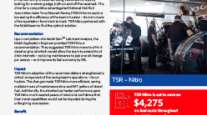Diesel Dips 0.8¢ to $2.608
This story appears in the July 6 print edition of Transport Topics.
U.S. retail diesel prices slipped 0.8 cent last week, providing a breather for the trucking industry after seven consecutive weeks of increases that had pushed the average cost to a seven-month high.
The dip left the national average cost of a gallon of trucking’s primary fuel at $2.608, the Department of Energy reported after its weekly survey of filling stations.
At the same time, DOE reported that the average price of a gallon of gasoline declined 4.9 cents, the first retreat after 11 consecutive weeks of increases. The national average for gasoline is now $2.642.
The recent run-up in diesel and gasoline prices has stalled because of lack of demand, said Neil Gamson, an economist with the Energy Information Administration, the DOE division that tracks oil prices and supplies.
“You have millions of barrels of distillate stocks on hand, more than we normally use, in storage,” Gamson said.
Diesel, along with heating oil, is made from distillate.
Late this spring, some economic analysts said they saw signs of life in the economy, and crude oil prices rose. But since then, optimism has been tempered by further job losses, and crude has held steady around $70 a barrel.
It fell to $69.31 on the New York Mercantile Exchange on July 1.
“The global economy still has not recovered, although there might be signs of it here and there,” Gamson said. “Demand, particularly for diesel, it’s going to be more sensitive to the economy than, let’s say, gasoline,” he said.
Diesel sales are the more accurate gauge of how the economy is performing, Gamson said, because diesel sales correlate with manufacturing and freight activity.
That led Roland Bellavance in Barre, Vt., to wonder when truckers will see diesel prices that reflect the supply glut.
“It’s come down a little, but not much, and we kind of based all this year’s pricing on $2.40 a gallon,” said Bellavance.
“I think over at the truck stop today it was $2.699,” Bellavance said on the same day that the government reported diesel prices had dipped slightly.
He is president of the family-owned Bellavance Trucking and president of the board of directors of the Vermont Truck and Bus Association.
As for the economy, “Things are so doggone slow that it’s terrible,” said Bellavance.
His flatbed fleet of roughly 100 trucks hauls Vermont granite around the country, mostly for cemetery memorials.
Just outside Denver, in Commerce City, Colo., Mike Riley, the chief financial officer and a partner in Westco Trucking Inc., also wondered when prices will reflect the diesel glut.
“Freight’s down, miles are down, demand’s down and the price of diesel’s up,” Riley said.
Worse yet for truckers in Riley’s part of the country, “If you look at the DOE [report], Rocky Mountain was the only one that went up” last week, he said.
DOE reported that diesel in the Rocky Mountain region — one of eight regions where DOE charts fuel prices weekly — rose 1.7 cents a gallon.
The biggest drop in the price of diesel occurred in the Midwestern region, where the economic downturn has caused the near collapse of American automobile manufacturing.
Despite the recent jump in prices, however, nothing in this year’s run-up in diesel has approached the per gallon price of the fuel last year, when on July 14, it hit an all-time record of $4.764.
That steep price jump and the global nature of this year’s recession led Phil Flynn, a senior analyst at Alaron Trading in Chicago, to caution against making traditional correlations between fuel prices and economic conditions and against blaming speculators for rising prices.
“You have to remember we’re going through something that we’ve never gone through in history,” Flynn said. “This financial crisis is different than anything we’ve ever met.”
Last summer, for example, Flynn said, diesel prices set records even though freight tonnage was dropping precipitously.
Now, tonnage is at all-time lows but diesel prices have climbed, he said.
Flynn also said that several refineries have started to come back on line, despite the reported glut in fuel, and that could help keep prices down.
The short-term bottom line, Flynn said, is that people should think seasonally about fuel prices.
“I think we’re seeing a seasonal peak, the Fourth of July,” he said. “We’re seeing signs that we’ve sort of peaked for the summer. I think prices could moderate a little bit, and then get ready for another spike as we get closer to winter” Flynn said.
Typically in the fall, diesel prices rise as demand awakens for heating oil, particularly in the northeastern region of the country.




